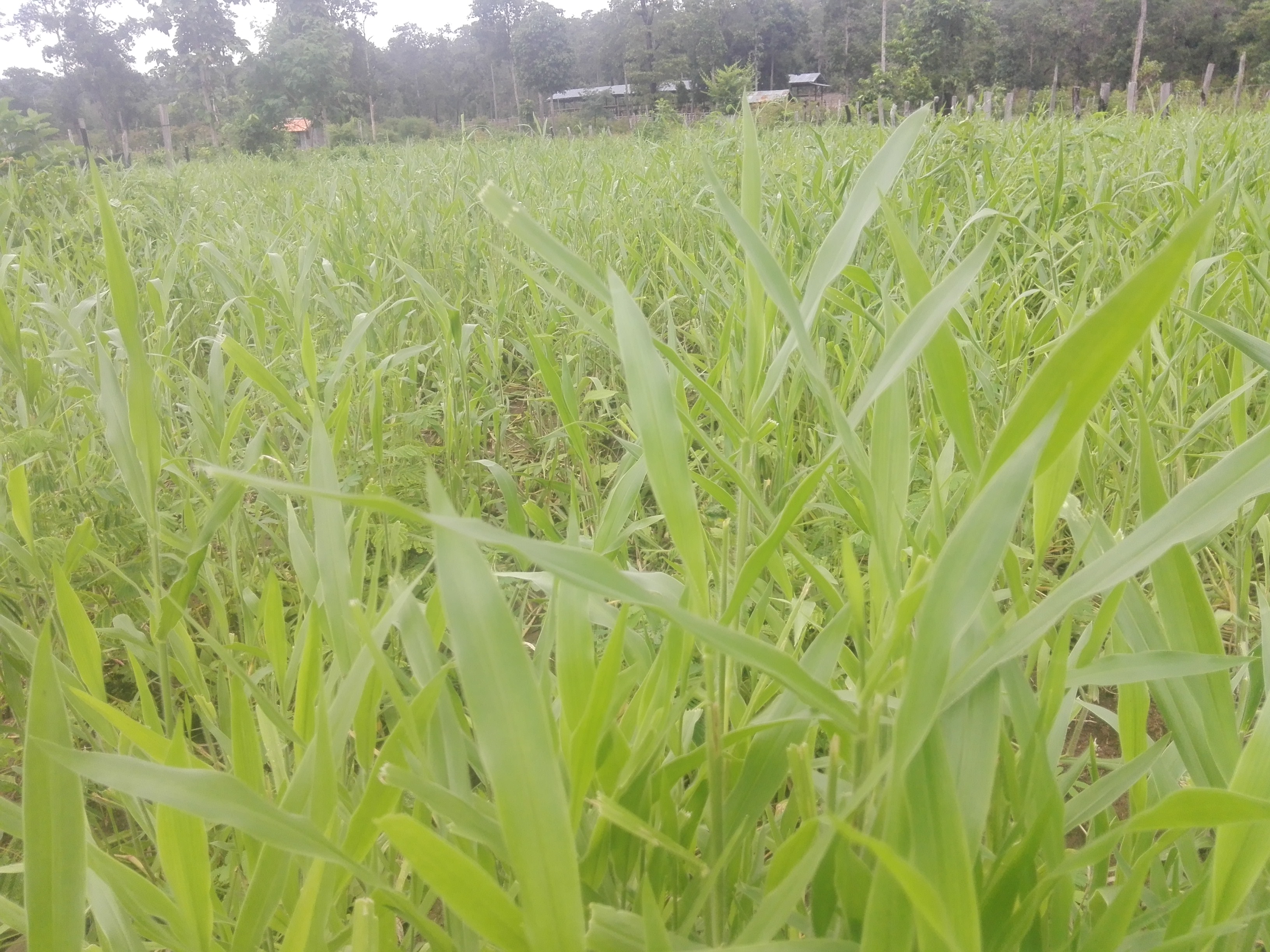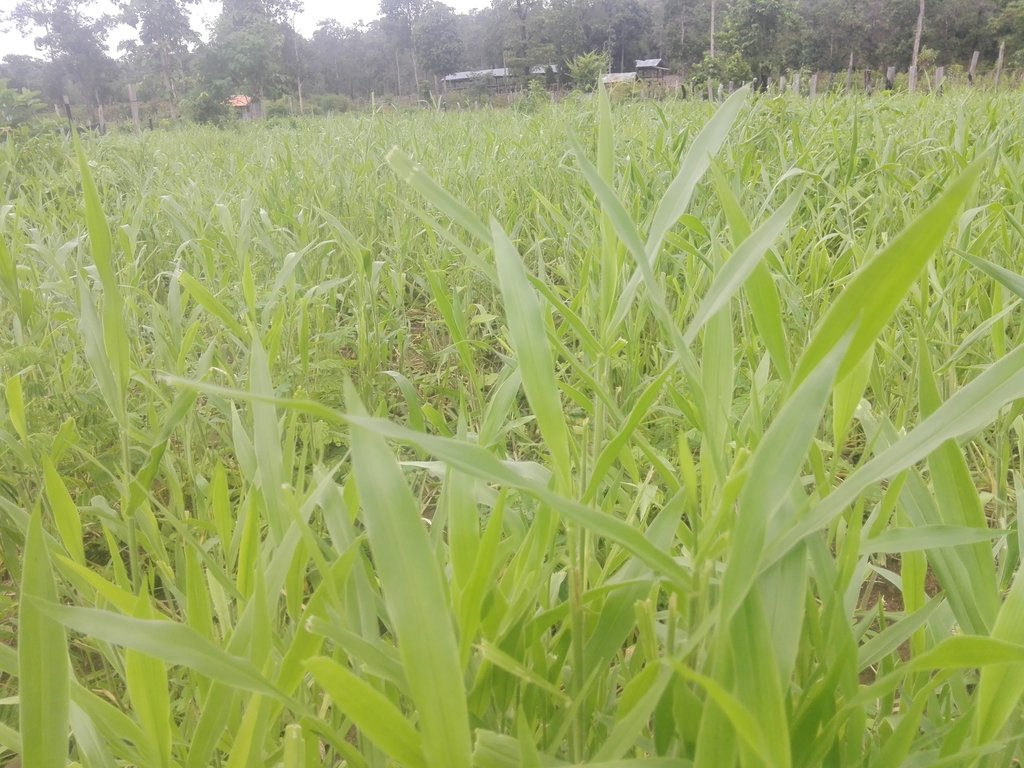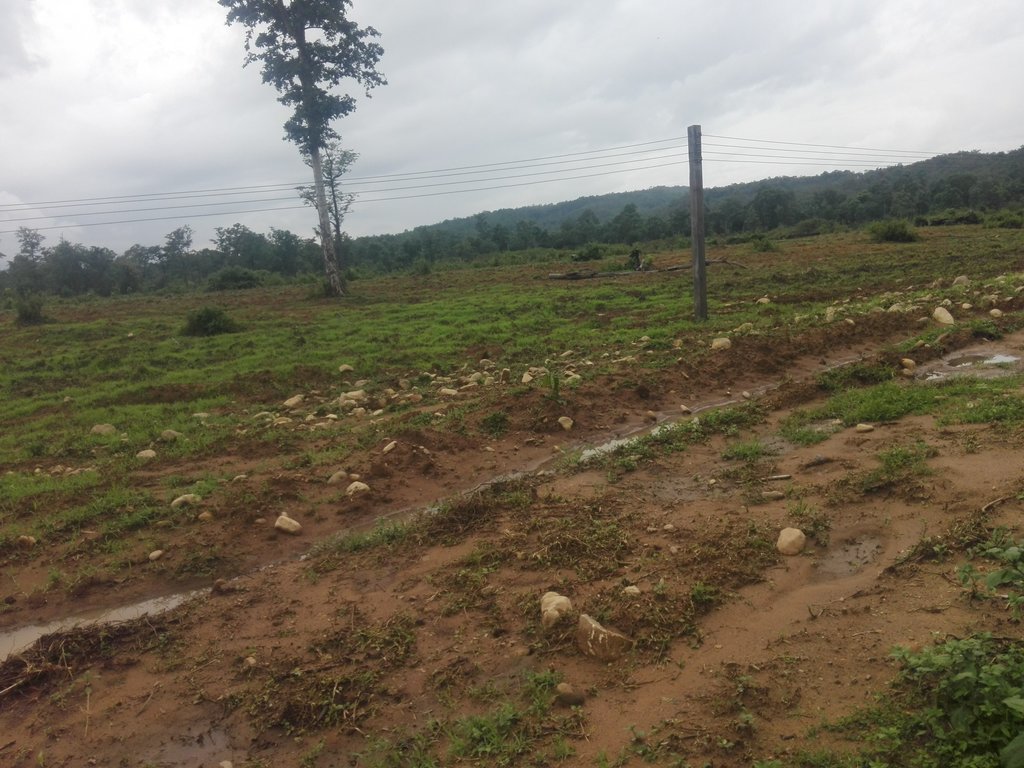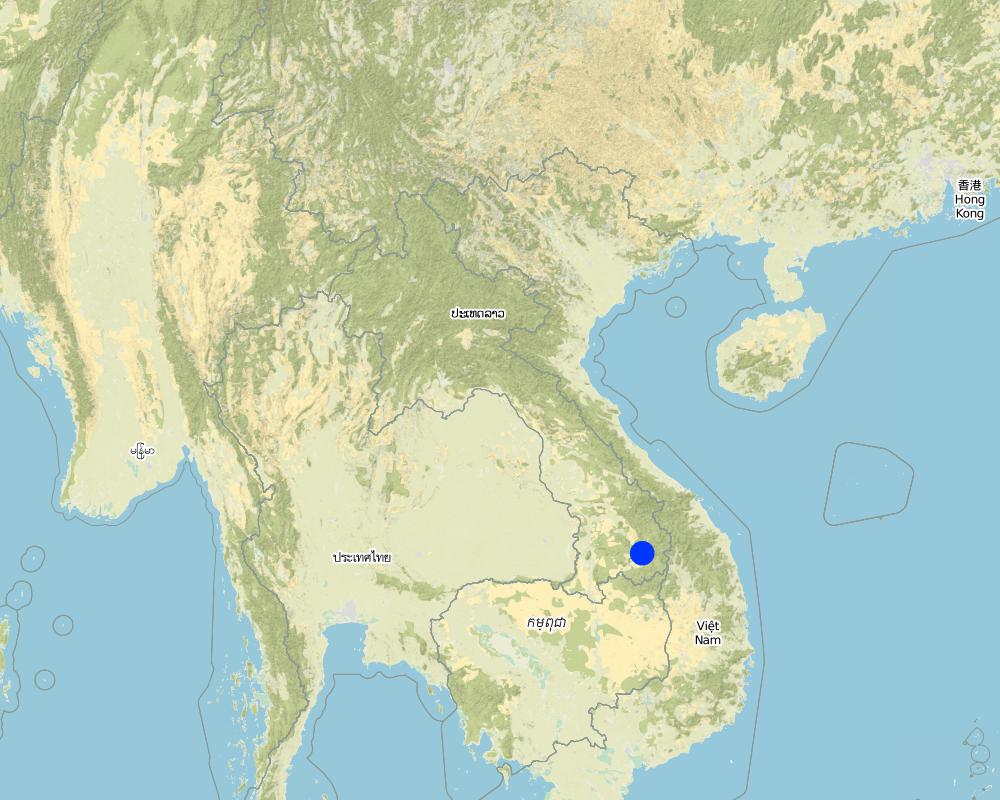Conversion of rocky area to grazing area for livestock management [Lao People's Democratic Republic]
- Creation:
- Update:
- Compiler: kang phanvongsa
- Editors: Bounthanom Bouahom, sinnilong vongkhamchanh
- Reviewers: Nicole Harari, Stephanie Jaquet
technologies_2891 - Lao People's Democratic Republic
View sections
Expand all Collapse all1. General information
1.2 Contact details of resource persons and institutions involved in the assessment and documentation of the Technology
Key resource person(s)
land user:
Keosymonkong Khamthy
020 99743368
Tadseng village Sansay district Attapue province
Lao People's Democratic Republic
SLM specialist:
Chaluensunk Amphone
030 4874017
District of Agriculture and Forest Office
Dakkiet village Sansay district Attapue province
Lao People's Democratic Republic
Name of project which facilitated the documentation/ evaluation of the Technology (if relevant)
Scaling-up SLM practices by smallholder farmers (IFAD)Name of the institution(s) which facilitated the documentation/ evaluation of the Technology (if relevant)
National Agriculture and Forestry Research Institute (NAFRI) - Lao People's Democratic Republic1.3 Conditions regarding the use of data documented through WOCAT
When were the data compiled (in the field)?
27/06/2017
The compiler and key resource person(s) accept the conditions regarding the use of data documented through WOCAT:
Yes
1.4 Declaration on sustainability of the described Technology
Is the Technology described here problematic with regard to land degradation, so that it cannot be declared a sustainable land management technology?
No
2. Description of the SLM Technology
2.1 Short description of the Technology
Definition of the Technology:
Forage and Livestock Management
2.2 Detailed description of the Technology
Description:
One of the main causes of land degradation in the Tadseng village (Sansay district, Lao PDR) is the flow of storm water that results in sediment run-off which leaves only rocks behind. It is estimated that approximately 20% of clay soils on the top soil have been washed away in recent years. In 2009 The Sustainable National Resources Management Product and Enhancement Project supported by Asia Development Bank (ADB) encouraged villagers to set up cow and forage farms. Ten cow breeding groups were established in the village. The cow farming group had used the communal land with a total 15 ha. After four years of implementation, some group members ignored their responsibilities and the group experienced a number of difficulties in both the management of the livestock and grass, which finally led to the collapse of the system. However, by 2014, one of the former members regained his interest in cow farming. He was able to rent the former 15 ha of land and he re-established the cow farm to a herd of 130 heads. At the beginning he only chose the healthiest stems of grass that remained from the old farm and replanted these. Three grass species were planted in rows on one area, namely Nepir, Guinea and Paspalum. It took thirty days to plow and prepare the land using a tractor and a labour force of more than fifty workers. For about five days, ten of these laborers had to remove the forage roots from the old fields. Generally, mid-May is the most suitable time to plant the grass as there is only a small amount of rain. Work begins by clearing the land and plowing the soil and then leaving it to dry for 15 days in order to get rid of some of the weeds and pests. During this period, some of the organic matter decays and develops into green compost which helps to improve the soil’s structure. This subsequently successfully regenerates the growth of the grass as its roots are able to easily expand throughout the soil. Whilst waiting for the soil to dry fences will be constructed around the plot. Then 40 tons of manure should be transported to the field using a two-wheel tractor. After, the manure has to be distributed and plowed into the soil. At the beginning of June grass can be planted by digging holes in rows, as to place the grass suckers into the ground at a depth of 5 cm. Irrigation is unnecessary as rain is expected in June. Optionally the farmer can use a gravity fed irrigation, if necessary. The forage can be harvested around 90 – 100 days after plantation. There are two options regarding the feeding of livestock: First option involves hired labourers to harvest the grass. The second option is to allow the livestock to graze freely in the field, 6 months after grass plantation. However, this can only be undertaken on a bi-weekly basis so as to allow the grass to regenerate. It is important to extract the weeds and apply organic fertilizer or green manure after the grass has been cut. Maintenance may also involve the repairing of fences. Advantages of this planting grass are the reduction of soil erosion and preventing nutrients from being washed out during heavy rains, as well as reducing soil compaction. Meanwhile the organic matter in the soil increases due to the decay of dead leaves of grass and roots. Further advantage is to grow up stronger and healthier cows. This also means that the farmers get higher household revenue from the sale of his livestock which on average amounts up to 80,000,000Kip/annum. Family members also have more time for other household activities because cows are released in the early morning and called back in late afternoon. However, one of the disadvantages could be a reduction in the local biodiversity such as edible insects and crickets. Furthermore the availability and variety of non-timber forest products declines such as Hed Amanita hemibapha, broom grass and rattan. Wildlife numbers have also reduced as people used to find and squirrels in this region. Another challenge may be that households have limited labour power to maintain fences and the forage fields, as it is relatively expensive to hire workers at 50,000 Kip/day. Difficulties in carrying out weeding include Nga Nam Keo. It should be noted that farmer make significant savings by not having to buy grass seeds as he can collect grass rhizomes from the old farm area.
2.3 Photos of the Technology
2.5 Country/ region/ locations where the Technology has been applied and which are covered by this assessment
Country:
Lao People's Democratic Republic
Region/ State/ Province:
Attapue province
Further specification of location:
Tadseng village Sansay district
Map
×2.6 Date of implementation
Indicate year of implementation:
2011
If precise year is not known, indicate approximate date:
- less than 10 years ago (recently)
2.7 Introduction of the Technology
Specify how the Technology was introduced:
- through land users' innovation
- through projects/ external interventions
Comments (type of project, etc.):
First project intervention in 2009: Sustainable National Resources Management Product and Enhancement Project supported by Asia Development Bank (ADB). Later in 2014 after project failure, technology has been relaunched by private initiative of a village's land user.
3. Classification of the SLM Technology
3.1 Main purpose(s) of the Technology
- reduce, prevent, restore land degradation
- create beneficial economic impact
- create beneficial social impact
3.2 Current land use type(s) where the Technology is applied

Grazing land
Extensive grazing land:
- Ranching
Intensive grazing/ fodder production:
- Improved pastures
Main animal species and products:
Napir (Pennisetum purpureum), Guinea and Paspalum grass commonly known is a popular fodder crop for small scale dairy farming.
3.3 Further information about land use
Water supply for the land on which the Technology is applied:
- mixed rainfed-irrigated
Comments:
Water from catchment
Number of growing seasons per year:
- 1
Specify:
Nepir grass
Livestock density (if relevant):
130 cows/15 ha
3.4 SLM group to which the Technology belongs
- pastoralism and grazing land management
- improved ground/ vegetation cover
3.5 Spread of the Technology
Specify the spread of the Technology:
- evenly spread over an area
If the Technology is evenly spread over an area, indicate approximate area covered:
- 0.1-1 km2
3.6 SLM measures comprising the Technology

management measures
- M2: Change of management/ intensity level
3.7 Main types of land degradation addressed by the Technology

physical soil deterioration
- Pc: compaction

biological degradation
- Bc: reduction of vegetation cover
- Bf: detrimental effects of fires

water degradation
- Ha: aridification
3.8 Prevention, reduction, or restoration of land degradation
Specify the goal of the Technology with regard to land degradation:
- restore/ rehabilitate severely degraded land
- adapt to land degradation
4. Technical specifications, implementation activities, inputs, and costs
4.1 Technical drawing of the Technology
Author:
Sinnalong Vongkhamdy
Date:
03/07/2017
4.2 Technical specifications/ explanations of technical drawing
Density of plants is 37,000 plants/ha
Planting area wide is 100 m, the length is 1500 m
The grass stems should be planted at a distance of 50 cm from each other and there should be a distance of 80 cm between the rows.
The land is in foot slop with slop about 3 - 5%
Plant varieties in use are e.g. Napir, Guinea, Paspalum
Growing period is 90 - 100 day before it can be cut.
Around the plot a barbed wire has been installed fore livestock control and to prevent other animals from outside. The fence was 1.5 m high with 5 lines of barbed wire from the top of the posts to the surface.
Further technical specifications: Land preparation involved the use of a tractor with 4,000 horse power engines. This grass cultivation technology is practiced around the foot slopes with an average gradient of 3-5%. Weeding and the application of fertilizer are required twice a year in May and December. The grass can be harvested around 90 – 100 days after it has been planted.
4.3 General information regarding the calculation of inputs and costs
Specify how costs and inputs were calculated:
- per Technology area
Indicate size and area unit:
ha
If using a local area unit, indicate conversion factor to one hectare:
15
other/ national currency (specify):
kip
Indicate exchange rate from USD to local currency (if relevant): 1 USD =:
8000.0
Indicate average wage cost of hired labour per day:
50000
4.4 Establishment activities
| Activity | Type of measure | Timing | |
|---|---|---|---|
| 1. | land estimation | Other measures | January-Febuary |
| 2. | land preparation | Structural | |
| 3. | Planting | Agronomic | |
| 4. | Fertilizing | Management | |
| 5. | Fencing | Structural |
4.5 Costs and inputs needed for establishment
If possible, break down the costs of establishment according to the following table, specifying inputs and costs per input. If you are unable to break down the costs, give an estimation of the total costs of establishing the Technology:
61878000.0
| Specify input | Unit | Quantity | Costs per Unit | Total costs per input | % of costs borne by land users | |
|---|---|---|---|---|---|---|
| Labour | planting labour | person-day | 20.0 | 50000.0 | 1000000.0 | 100.0 |
| Labour | fencing labour | person-day | 30.0 | 50000.0 | 1500000.0 | 100.0 |
| Labour | fertilizing labour | person | 60.0 | 50000.0 | 3000000.0 | 100.0 |
| Equipment | Hummer | piece | 6.0 | 35000.0 | 210000.0 | |
| Equipment | Draper Fence Wire Tensioning Tool | piece | 3.0 | 170000.0 | 510000.0 | |
| Equipment | Manure transfer by tractor | trip | 60.0 | 35000.0 | 2100000.0 | |
| Equipment | Glass packing machine | Machine | 3.0 | 1500000.0 | 4500000.0 | |
| Plant material | Paspalum seeds | Kg | 55.0 | 50000.0 | 2750000.0 | |
| Plant material | Guniea seeds (Megathyrsus maximus) | Kg | 40.0 | 50000.0 | 2000000.0 | |
| Plant material | Napier seeds (Pennisetum purpureum) | Kg | 35.0 | 50000.0 | 1750000.0 | |
| Fertilizers and biocides | Manure | ton | 40.0 | 200000.0 | 8000000.0 | 100.0 |
| Construction material | Nail | box | 1.0 | 80000.0 | 80000.0 | |
| Construction material | Wire | roll | 48.0 | 250000.0 | 12000000.0 | |
| Construction material | Post hole | hole | 1600.0 | 10000.0 | 16000000.0 | |
| Construction material | Fence post | piece | 1600.0 | 3000.0 | 4800000.0 | |
| Total costs for establishment of the Technology | 60200000.0 | |||||
If land user bore less than 100% of costs, indicate who covered the remaining costs:
Equipment, plan material and construction material support by ADB project
4.6 Maintenance/ recurrent activities
| Activity | Type of measure | Timing/ frequency | |
|---|---|---|---|
| 1. | Fertilizing | Agronomic | annually, each cultivating season |
| 2. | Cutting the grass | Management | during growing period |
| 3. | Weeding | Management | after harvest |
| 4. | Fence repair | Structural | after harvest |
Comments:
Annually maintenance
4.7 Costs and inputs needed for maintenance/ recurrent activities (per year)
| Specify input | Unit | Quantity | Costs per Unit | Total costs per input | % of costs borne by land users | |
|---|---|---|---|---|---|---|
| Labour | Labor | person-day | 50.0 | 30000.0 | 1500000.0 | 100.0 |
| Equipment | Hoe | piece | 25.0 | 30000.0 | 750000.0 | |
| Total costs for maintenance of the Technology | 2250000.0 | |||||
4.8 Most important factors affecting the costs
Describe the most determinate factors affecting the costs:
The high cost for fencing and the construction material are the most important factors
5. Natural and human environment
5.1 Climate
Annual rainfall
- < 250 mm
- 251-500 mm
- 501-750 mm
- 751-1,000 mm
- 1,001-1,500 mm
- 1,501-2,000 mm
- 2,001-3,000 mm
- 3,001-4,000 mm
- > 4,000 mm
Specify average annual rainfall (if known), in mm:
2500.00
Specifications/ comments on rainfall:
The driest month is January. There is 7 mm of precipitation in January. With an average of 501 mm, most of precipitation falls in June/August. Annual rainfall is 2300 mm
Indicate the name of the reference meteorological station considered:
Sanxai natural resource and environmental district office
Agro-climatic zone
- sub-humid
With an average of 28.4 °C May is the warmest month. January has the lowest average temperature of the year. It is 22.6 °C
5.2 Topography
Slopes on average:
- flat (0-2%)
- gentle (3-5%)
- moderate (6-10%)
- rolling (11-15%)
- hilly (16-30%)
- steep (31-60%)
- very steep (>60%)
Landforms:
- plateau/plains
- ridges
- mountain slopes
- hill slopes
- footslopes
- valley floors
Altitudinal zone:
- 0-100 m a.s.l.
- 101-500 m a.s.l.
- 501-1,000 m a.s.l.
- 1,001-1,500 m a.s.l.
- 1,501-2,000 m a.s.l.
- 2,001-2,500 m a.s.l.
- 2,501-3,000 m a.s.l.
- 3,001-4,000 m a.s.l.
- > 4,000 m a.s.l.
Indicate if the Technology is specifically applied in:
- not relevant
5.3 Soils
Soil depth on average:
- very shallow (0-20 cm)
- shallow (21-50 cm)
- moderately deep (51-80 cm)
- deep (81-120 cm)
- very deep (> 120 cm)
Soil texture (topsoil):
- medium (loamy, silty)
Soil texture (> 20 cm below surface):
- medium (loamy, silty)
Topsoil organic matter:
- medium (1-3%)
5.4 Water availability and quality
Ground water table:
5-50 m
Availability of surface water:
medium
Water quality (untreated):
for agricultural use only (irrigation)
Is water salinity a problem?
No
Is flooding of the area occurring?
No
5.5 Biodiversity
Species diversity:
- medium
Habitat diversity:
- medium
5.6 Characteristics of land users applying the Technology
Sedentary or nomadic:
- Sedentary
Market orientation of production system:
- commercial/ market
Off-farm income:
- less than 10% of all income
Relative level of wealth:
- average
- rich
Individuals or groups:
- individual/ household
Level of mechanization:
- mechanized/ motorized
Gender:
- men
Age of land users:
- middle-aged
5.7 Average area of land owned or leased by land users applying the Technology
- < 0.5 ha
- 0.5-1 ha
- 1-2 ha
- 2-5 ha
- 5-15 ha
- 15-50 ha
- 50-100 ha
- 100-500 ha
- 500-1,000 ha
- 1,000-10,000 ha
- > 10,000 ha
Is this considered small-, medium- or large-scale (referring to local context)?
- large-scale
5.8 Land ownership, land use rights, and water use rights
Land ownership:
- communal/ village
Land use rights:
- individual
Water use rights:
- individual
5.9 Access to services and infrastructure
health:
- poor
- moderate
- good
education:
- poor
- moderate
- good
technical assistance:
- poor
- moderate
- good
employment (e.g. off-farm):
- poor
- moderate
- good
markets:
- poor
- moderate
- good
energy:
- poor
- moderate
- good
roads and transport:
- poor
- moderate
- good
drinking water and sanitation:
- poor
- moderate
- good
financial services:
- poor
- moderate
- good
6. Impacts and concluding statements
6.1 On-site impacts the Technology has shown
Socio-economic impacts
Production
crop production
Comments/ specify:
Previously the soil was mixed with rocks and big stones, so that it was difficult for planting. By applying the grass cultivation method and gradually remove of those stones and rocks crop production is increased.
fodder production
Comments/ specify:
Before the land user let his animals take up only natural grass from the sourroundings. After, by cultivating different grass varieties in a large area the fodder production increased substantially
fodder quality
Comments/ specify:
Natural grass is low in nutrients and proteins necessary for animal growth compared to the high potential grass varieties planted by the farmer. This grass varieties have many nutrients and proteins required for animal husbandry.
animal production
Comments/ specify:
Previously the lack of fodder for animal husbandry resulted in low animal production. From the moment the farmer was able to get enough fodder from his grasslands the animal production increased significantly.
risk of production failure
Comments/ specify:
Because limited fodder especially in dry season the animal production failure quit a problem. From the moment he was able to produce high valued animal fodder on a large area the risk of production failure decreased to some extent.
product diversity
Comments/ specify:
Before the farmer got only natural grass from the surroundings, but now he produce Napir grass, Guinea grass, Paspalum grass by himself.
production area
Comments/ specify:
Before animal husbandry is dependet from natural forests and from rice fields. After the farmer was able to expand the productive area by 15 square metres of grassland.
land management
Comments/ specify:
Before the animal had grazed freely in the village sourroundings and so the farmer had to guard them. After grass cultivation the animals graze on fenced grass lands on a bi-weekly basis. And futher the cattle can be fed by own freh or dried fodder grass.
Income and costs
expenses on agricultural inputs
Comments/ specify:
There enlarged area called for more monetary inputs to establish the cattle farm and to cultivate the additionoal 15 ha (new expenses: cattle housing, fencing, grass varieties and farm maintenance).
farm income
Quantity after SLM:
80,000,000 kip/annual
Comments/ specify:
The increase in revenues base on the fact, that now the farmer can sell many healty and strong cows every year at a good price. Actually, he produces cows even for the export to Vietnam.
diversity of income sources
Comments/ specify:
Before cows has been sold in few numbers. After the application of the technology the farmer raises besides of a larger amount of cows also goats, pigs, poultry for the market. In addition he can sell different grass seed varieties.
workload
Comments/ specify:
Previously the animal raising based on free grazing in the village sourroundings. The establishment and maintenance of the new grassland area and the increased cow herd and other livestock resulted in increased workload.
Ecological impacts
Soil
soil cover
Comments/ specify:
The soil cover increased significantly because of the cultivation ot the strong and expansive grass varieties.
soil loss
Comments/ specify:
The soil can be fixed by the expanding and deep roots of the different grass varieties. Furhtermore, grass residues promote better soil cover that reduces soil loss by water erosion too.
soil accumulation
Comments/ specify:
During the rainy season the plant detritus and manure promote soil accumulation.
soil compaction
Comments/ specify:
The expanding and deep root system of the grass cultivation improves the soil structure significantly.
6.3 Exposure and sensitivity of the Technology to gradual climate change and climate-related extremes/ disasters (as perceived by land users)
Gradual climate change
Gradual climate change
| Season | Type of climatic change/ extreme | How does the Technology cope with it? | |
|---|---|---|---|
| annual temperature | increase | not known | |
| seasonal temperature | dry season | increase | well |
| annual rainfall | decrease | moderately | |
| seasonal rainfall | wet/ rainy season | decrease | moderately |
| other gradual climate change | increase | not known |
Climate-related extremes (disasters)
Meteorological disasters
| How does the Technology cope with it? | |
|---|---|
| local rainstorm | moderately |
| local windstorm | moderately |
Climatological disasters
| How does the Technology cope with it? | |
|---|---|
| extreme winter conditions | moderately |
| drought | not well |
Biological disasters
| How does the Technology cope with it? | |
|---|---|
| insect/ worm infestation | moderately |
6.4 Cost-benefit analysis
How do the benefits compare with the establishment costs (from land users’ perspective)?
Short-term returns:
negative
Long-term returns:
positive
How do the benefits compare with the maintenance/ recurrent costs (from land users' perspective)?
Short-term returns:
slightly positive
Long-term returns:
positive
6.5 Adoption of the Technology
- single cases/ experimental
If available, quantify (no. of households and/ or area covered):
15
Of all those who have adopted the Technology, how many have did so spontaneously, i.e. without receiving any material incentives/ payments?
- 90-100%
Comments:
The farmer in this case study adopted the technology.The main problem are the high investment costs.
6.6 Adaptation
Has the Technology been modified recently to adapt to changing conditions?
Yes
other (specify):
ownership and organization
Specify adaptation of the Technology (design, material/ species, etc.):
At the beginning in 2009, the technology covered 15 ha of village land and had been established by project support and maintained by breeding groups. Later in 2014 - after project failure due to organizational and maintenance difficulties - one land user of the village rent this land from the local autorities and applied the Technology by himself.
6.7 Strengths/ advantages/ opportunities of the Technology
| Strengths/ advantages/ opportunities in the land user’s view |
|---|
| Initially the project (ADB) provided an equipment, grass seeds and land preparation |
| Improved the livestock quality |
| Increased household income from livestock |
| Strengths/ advantages/ opportunities in the compiler’s or other key resource person’s view |
|---|
| Improved soil quality due to animal manure and plant detritus |
6.8 Weaknesses/ disadvantages/ risks of the Technology and ways of overcoming them
| Weaknesses/ disadvantages/ risks in the land user’s view | How can they be overcome? |
|---|---|
| Insufficient water in dry season which effects limited grass production | water harvesting area is required |
| Difficult to control the animals in such large area | restrict the grazing areas |
| Difficult to collect manure for fertilizing the soil |
7. References and links
7.1 Methods/ sources of information
- field visits, field surveys
1 time for field visit
- interviews with land users
2 persons
Links and modules
Expand all Collapse allLinks
No links
Modules
No modules





